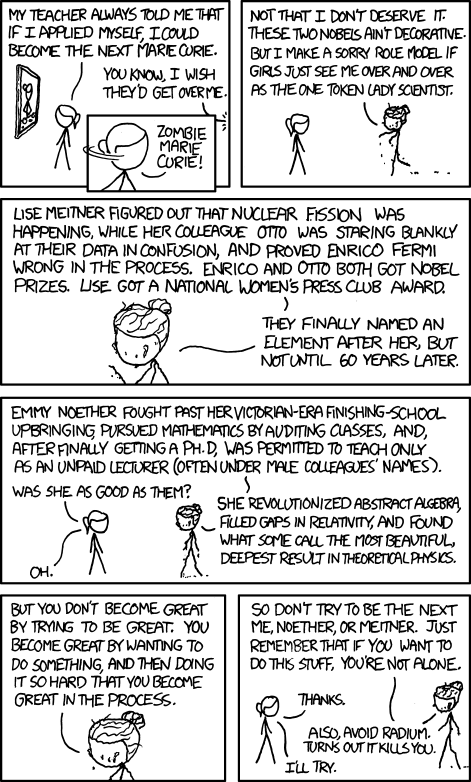Awesomeness Round-up – 5/9/11
- By Maggie Masetti
- May 9, 2011
- Comments Off on Awesomeness Round-up – 5/9/11
If you’re in the DC metro area and free on Saturday, May 14, come to our open house, Explore@NASAGoddard. It’s free, and runs 11-5. You can find more details on this site, but watch out, it’ll automatically start playing a video, so you might want to turn your sound down. You can download an event program here. At Building 29, you can learn more about JWST. Our guest blogger, Dr. Amber Straughn will be speaking at 4pm. Over at Building 34, our own Astrophysics Science Division will have a bunch of activities. There will be lots more to see and do, so come check it out!
xkcd is one of our favorite online comic strips – and we’re not the only one at NASA it’s popular with. It’s an irreverant look at science, pop culture, and many other topics of geek interest. (We’ll also warn you at that some of the strips use adult language and have adult concepts in them.)
I really enjoyed today’s strip and wanted to share it.

(and the mouseover: “Although not permanently.”)
Big news from the Gravity Probe B (GP-B, which confirmed two key predictions of Albert Einstein’s general theory of relativity, that space and time are actually warped by the gravity of a body, and a spinning object will pull space and time with it as it rotates. These predictions boil down to this – gravity affects space-time.
How did GP-B test this? It pointed at a single star called IM Pegasi while in a polar orbit around Earth. If gravity did not affect space and time, then GP-B’s gyroscopes would basically point forever in the same direction while in orbit. But the gyros experienced small but measurable changes in the direction of their spin from the pull of Earth’s gravit.
Francis Everitt, the GP-B principle investigator explained it his way. “Imagine the Earth as if it were immersed in honey. As the planet rotates, the honey around it would swirl, and it’s the same with space and time.” He added, “GP-B confirmed two of the most profound predictions of Einstein’s universe, having far-reaching implications across astrophysics research. Likewise, the decades of technological innovation behind the mission will have a lasting legacy on Earth and in space.”
Here’s a short video that explains the experiment more visually.
There’s also an excellent article that gives more detail on NASA Science News.
There may be a new kind of black hole. We know there are black holes that are the endpoints of the life of massive stars, and supermassive ones that are at the center of galaxies. There are theoretically suggested (and harmless) microscopic black holes that could be created by particle accelerators like the Large Hadron Collider. But now theory suggests that there might be primordial black holes that were produced immediately after the Big Bang. And they might even still be around today, 13.7 billion years after their creation. Even weirder is the suggestion that there might be black holes around today that were created before the Big Bang. Yes, before.
This new theory operates on the idea that before the Big Bang, a previous universe underwent a Big Crunch. After this big gravitational collapse, all matter in the universe contracted to a point, then then rebounded in a Big Bang birthing the universe we know now. If this was indeed the case, then you would think that everything from the previous universe was destroyed in the Big Bang explosion. Or even before that, if all that matter was mashed and blended together, so how could we hope to know anything about that previous universe?
Well, the theory is that perhaps black holes that were created with the matter in the universe compacted together actually survived the Big Bang and were dispersed throughout the current universe.
This blows our minds too. Read more over at Discovery News. Here’s the abstract for the actual paper.
Here’s a fascinating look at how the Apollo spacesuits were sewn by ILC in Dover, DE.

Credit: Jean Masetti
Here’s a TED talk by cosmologist Sean Carroll about this question: “Does time exist at all?” Sounds like one for the Doctor. (Who?)
In other NASA Goddard news, recently retired astronaut Piers Sellers is coming back to Goddard. He’ll be the new deputy director of the Sciences and Exploration Directorate. He used to work in earth science at Goddard once upon a time. I imagine it’ll be nice for him to be back, although he was off doing something pretty cool while he was away!
Want to know about how science is down via small shuttle payloads? There’s a whole program devoted to it.

Credit: NASA


